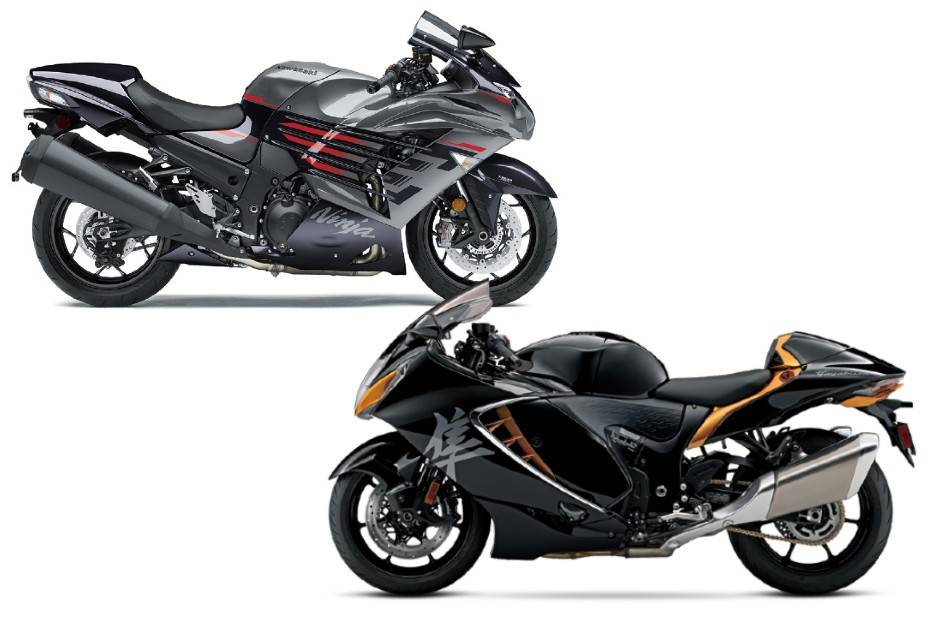2021 Suzuki Hayabusa vs 2021 Kawasaki Ninja ZX-14R: Photo Comparison
Modified On June 4, 2021 15:08 IST
By Punya Sharma for Suzuki Hayabusa
- 3212 Views
Two of the fastest production bikes ever pinned against each other

Ask any two-wheeler fanatic about the fastest production bikes, and the rivalry between two Japanese legends, the Suzuki Hayabusa and the Kawasaki Ninja ZX-14R, will surely come up. The two have shared the stage for a long time and continue to do so in 2021 with the latest iterations of their hyperbikes. So, how do they fare against each other now? Here’s a photo comparison answering exactly that:
Aesthetics


Both these bikes were known for their road presence and flowing design language in the old days, and fortunately that remains unchanged for 2021. Both bikes stay true to their original aerodynamic form, but take two different approaches.

The 2021 Suzuki Hayabusa, however, receives a massive update, which makes it look much more aerodynamic than before, thanks to its sharper fascia, wing-like air intakes, and new fairings with internal exhaust vents. Its overall silhouette is still in line with the iconic ‘Busa styling’, even though it gets an all-new headlamp, taillight and exhausts.

On the other hand, Kawasaki has taken a more conventional approach with the 2021 Ninja ZX-14R. Instead of an overhaul, all it gets is a new metallic gray paint scheme with sporty red accents. The ZX-14R still looks quite good, though, and will surely turn a few heads. That said, it’s really no match for the revamped Busa. Even the ZX-14R’s quad-projector headlamp appears dated compared to the Hayabusa’s all-LED lighting.


The Hayabusa’s new flatter tail section featuring a split LED taillight looks sleeker than the one on the ZX-14R.
Features


Again, the Kawasaki ZX-14R shows its age here. Both bikes have always had twin-pod digital-analogue instrument consoles, though the ZX-14R’s display relayed information more comprehensively than the previous-gen Busa’s cluster. But that too has changed with the new Hayabusa, courtesy a TFT display positioned between the dials, displaying a plethora of information, while the ZX-14R’s console remains unchanged.


Besides, the 2021 Hayabusa also gets a host of electronic aids like cruise control, wheelie control, lean angle indicator, cornering ABS, and a quickshifter to name a few, whereas the ZX-14R only gets two riding modes and traction control.
- Suzuki Burgman Electric: What To Expect From The Brand’s First E-scooter?
- Kawasaki Ninja ZX-4R Patent Filings Emerge
- Kawasaki Ninja 400 Updated For 2021
Engine

Both these bikes carry forward their respective inline-four motors (1,441cc for the ZX-14R and 1,340cc for the Hayabusa) producing the same power as before too (200PS for the ZX-14R and 190PS for the Hayabusa). Clear win for the Ninja, right?

Not really. What the Kawasaki doesn’t do is meet strict Euro-5 emissions norms which limits it to only the American and Japanese markets, whereas the Hayabusa’s engine has undergone several internal tweaks to not only make it Euro-5 compliant, but smoother, more linear, and punchier, as claimed by Suzuki.
Underpinnings


Both bikes pack similar underpinnings like an adjustable USD fork and monoshock, twin disc brakes up front with dual-channel ABS, and 17-inch alloys, but there are some key differences. For instance, both bikes use Brembo brake caliper up front, but the Hayabusa uses the top-of-the-line Stylema, while the ZX-14R uses the older M50. The new Hayabusa’s suspension, too, has tweaked internals to improve the riding dynamics.


Another point in favour of the Hayabusa is its weight. At 264kg, it is pretty heavy, but it still weighs 4kg less than the 2021 ZX-14R.
Prices

As mentioned earlier, since the Kawasaki ZX-14R doesn’t meet Euro-5 norms, it won’t be coming to India. So let’s talk about the prices in the USA. The 2021 Kawasaki Ninja ZX-14R is priced at $15,400 (about Rs 11.25 lakh), a massive $3,200 (Rs 2.3 lakh) cheaper than the 2021 Hayabusa in the USA, giving it a significant price advantage. But, bearing in mind the level of equipment and components offered on the Hayabusa, we think Suzuki has a clear winner on their hands.
